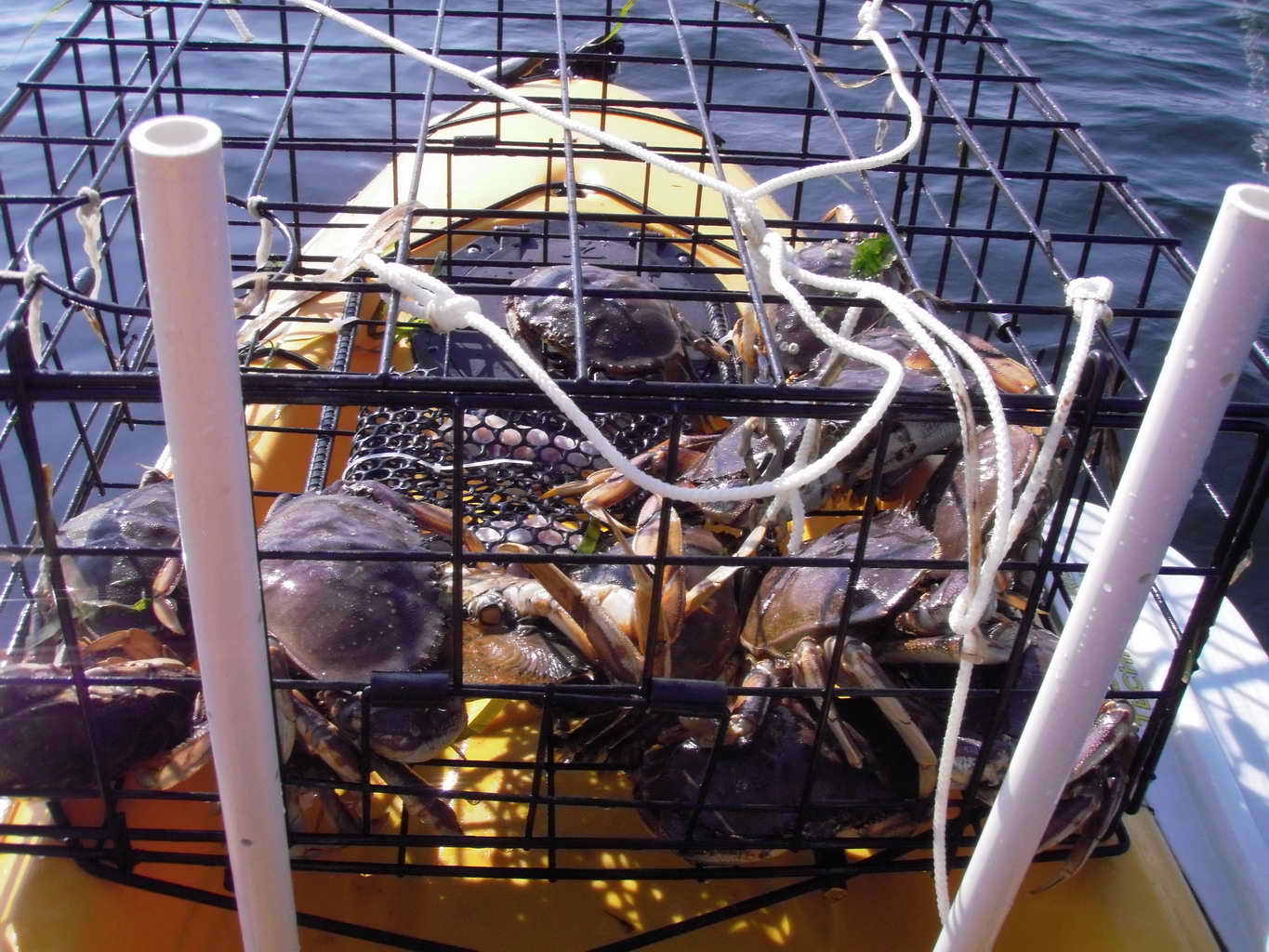
However, a few days later I repeated the drill. Dropped the traps in about 65' of water at low tide with a 14' tidal exchange. Already this season I've seen a couple submerged floats because people did not take the tide into account. Once the float is under water it can lighten the trap and hop it off the bottom to move in the current. Also it is a hazard to navigation. My default lines are 100' with 8 oz line weights 12' from the float.
Again, fished for a few hours with no luck, then pulled the traps. The first trap was filled with 17 crabs. I got 5 7" male keepers. The second trap was empty with the bait eaten. I think something held one of the doors open so the crabs could some and go. In any case I got my limit, and I did take a photo.

I had a plan for the crabs, so I'd brought a 5 gallon bucket which I filled with salt water and dropped in the crabs. A couple moms with 3 dogs and 3 kids (4-7) came by and wanted to look at the crabs, so I lifted one out and let them touch it. A little girl asked me what I was going to do with it and I said, "Take them home and eat them". See looked at me like I was crazy.
I gave one of the crabs to a guy at the beach that lets me park my truck in his yard when I launch the kayak. We would eat 2 for dinner. The last two I put in the downstairs "beer" fridge in the saltwater bucket hoping they would survive overnight so I could take fresh, live crab to my Mom the following day for lunch. It worked! I picked up some cob corn, grabbed a couple beers from the fridge and cooked my Mom corn and crab for lunch. See loved it. We had talked of my crabbing before and as kids my folks would occasionally bring home crab from the Pike Street Public Market. This was back in the old days when you could actually park a car in downtown Seattle. The crabs from the market were cooked and cleaned. I mentioned to Mom that a fresh, live crab tasted very different, much sweeter and juicier, than one cooked and cleaned and only held overnight. She agreed.
It is good to make one's Mom happy.
The white PVC sticking up are my "trap stays". It is a PVC 'H' with the shorter lower legs stuck into the scuppers of the kayak. When transporting the collapsed traps I drop them over the PVC so they cannot slide off the side.
For the past week we have been having morning fog which lasted until late morning or even noon. The fog lifted to reveal a CAVU day - Clear And Visibility Unlimited - and I got to the airport about noon. By the time I had completed a few tasks and finished the pre-flight I didn't take off from Harvey (S43) until about 1:30PM. I turned south and climbed, headed toward North Bend to follow Snoqualmie pass across the mountains. Although the temperature at altitude was warm, the new engine baffling keeps the engine oil quite cool, rarely going beyond 180F, which probably is not good. I should check the accuracy of the sending unit. There have been raging forest fires in Asia that have been hazing up our air here for the past week or so, and today the ceiling on the haze was about 6000'. Below that visibility was about 50 miles, but above is was unlimited, hundreds of miles.
By the time I reached North Bend and the entrance to the pass I was at 7500' where the air was glass smooth and the temperature just over 50F - that's warm. I like Snoqualmie Pass as a Cascade Mountains crossing because there are runways about every 17 nm from North Bend to Ellensburg, Fall City (), Bandera (4W0, 2300', gravel), Easton (ESW, 2600', turf), Cle Elum (S93, 2500', paved), and Ellensburg (ELN, 5600', paved). As well as the runways there is I-90 below. I landed at ELN about 2:30PM and spent only about 20 minutes on the ground - just a bio break. And it was hot, over 90F, probably more on the tarmac. The airport elevation is 1764', but the density altitude was 4500'. The trip back was at 8500', again glass smooth and warm - the altimiter was reading 8500', but the GPS was reading over 9000'. This is because the temperature at the altitude was much higher than in the standard reference atmosphere. The danger is when the air temp is LOWER than the standard reference, then your actual altitude is LOWER than your altimeter reading. The mnemonic is easy - Higher is Higher, and Lower is Lower.
I can't resist taking photos of Mt. Rainier, so here are a couple. They were taken from just west of Bandera airfield at 8500'.
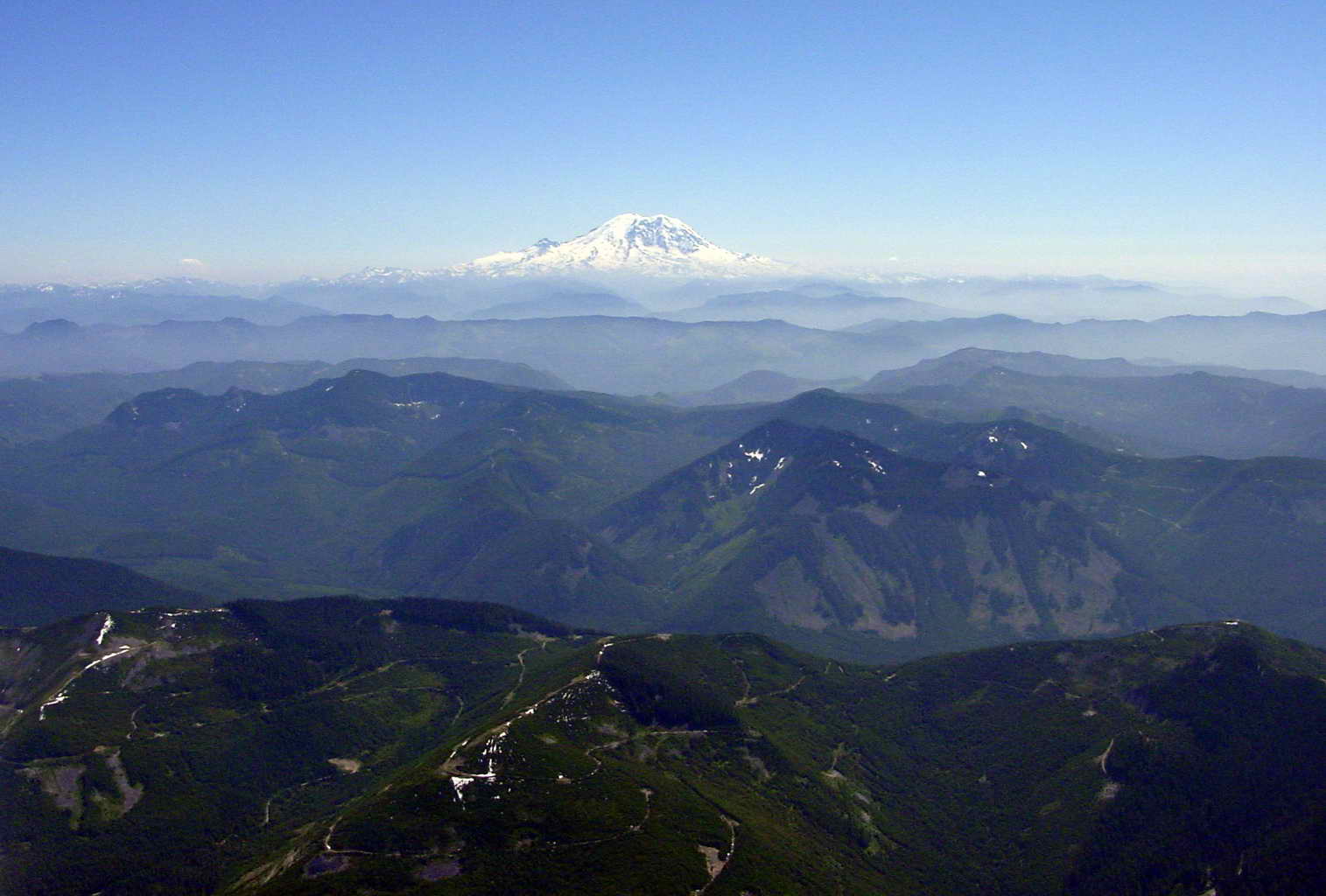
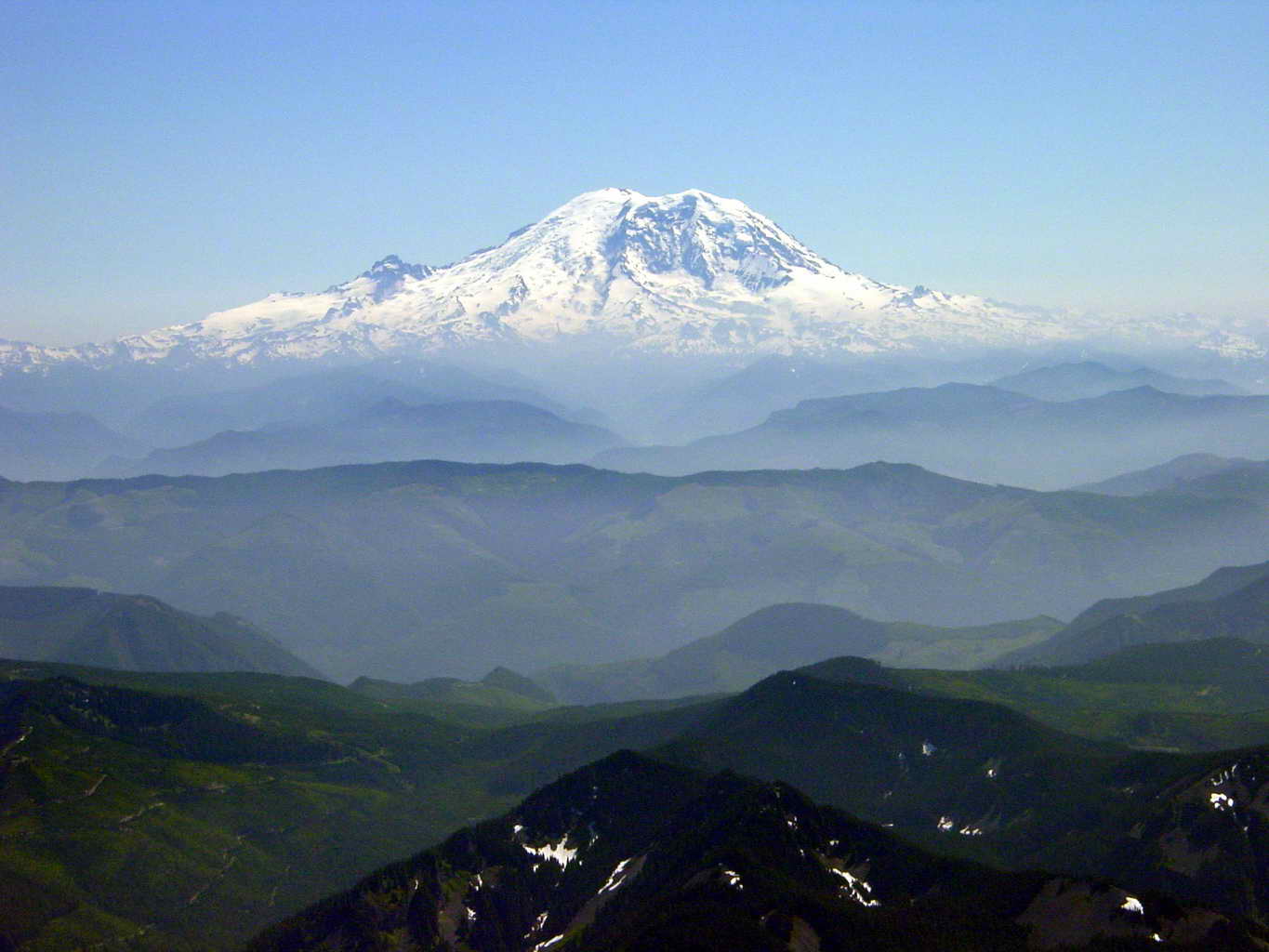
I did GPS log the flight. If you're interested in "flying" it, here's a link
Cloud Ahoy Flight Log
Here are the tomatoes that are against the fence. They get sun all day until late afternoon and the weathered wood makes a pretty good heat/light reflector, and the black plastic keeps the soil warm.
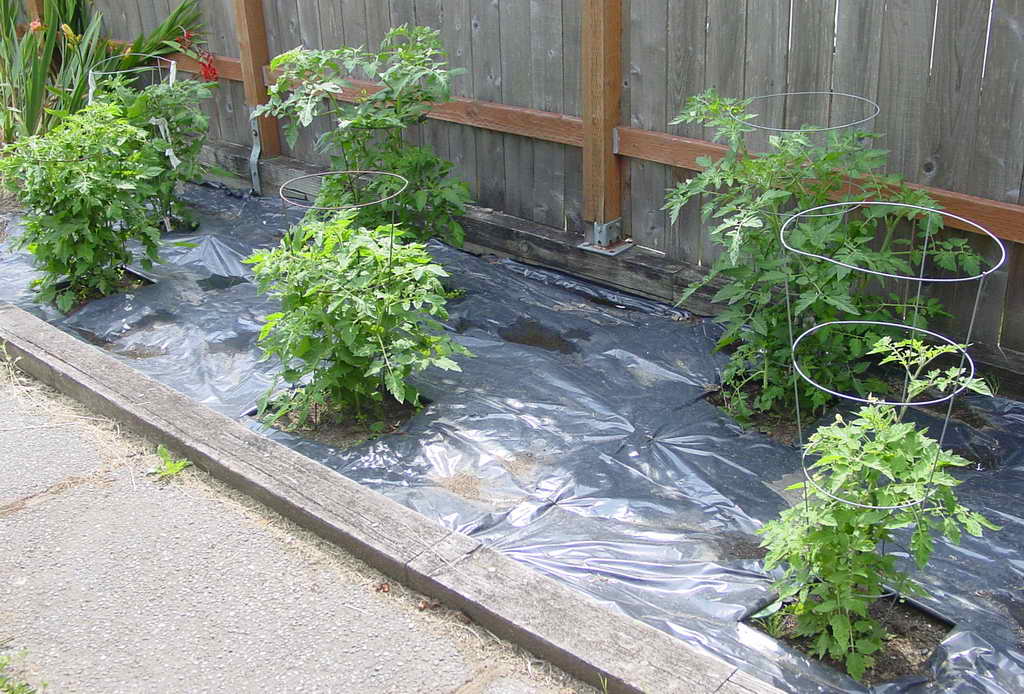
The entire garden has started to take off since the summer weather started on 05 July. The tall, back row is a double row of rasberries. The left third are yellow and the rest are red.
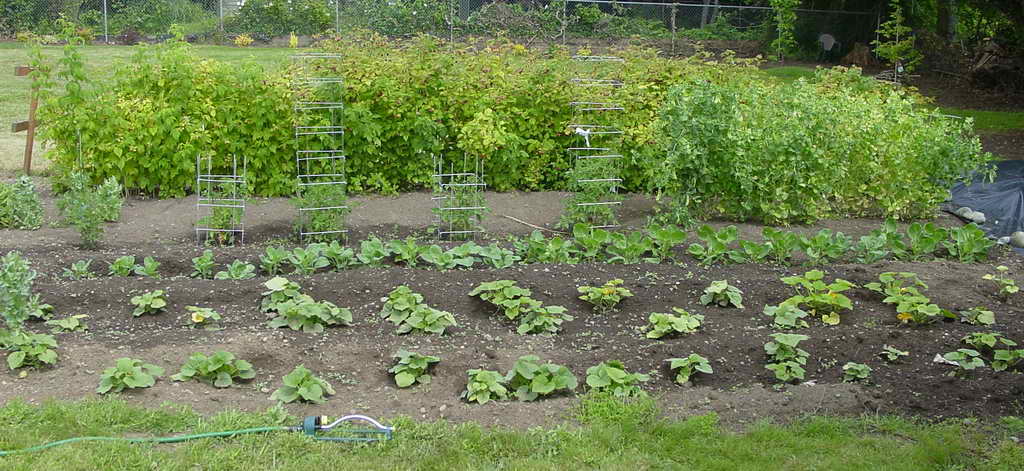
The caged plants are more tomatoes, and to the right of those are the peas which are just starting to die back.
The next row are brussel sprouts, then comes three rows of mixed squash and pumpkin. We are no longer sure which are which, so the fruit will tell.
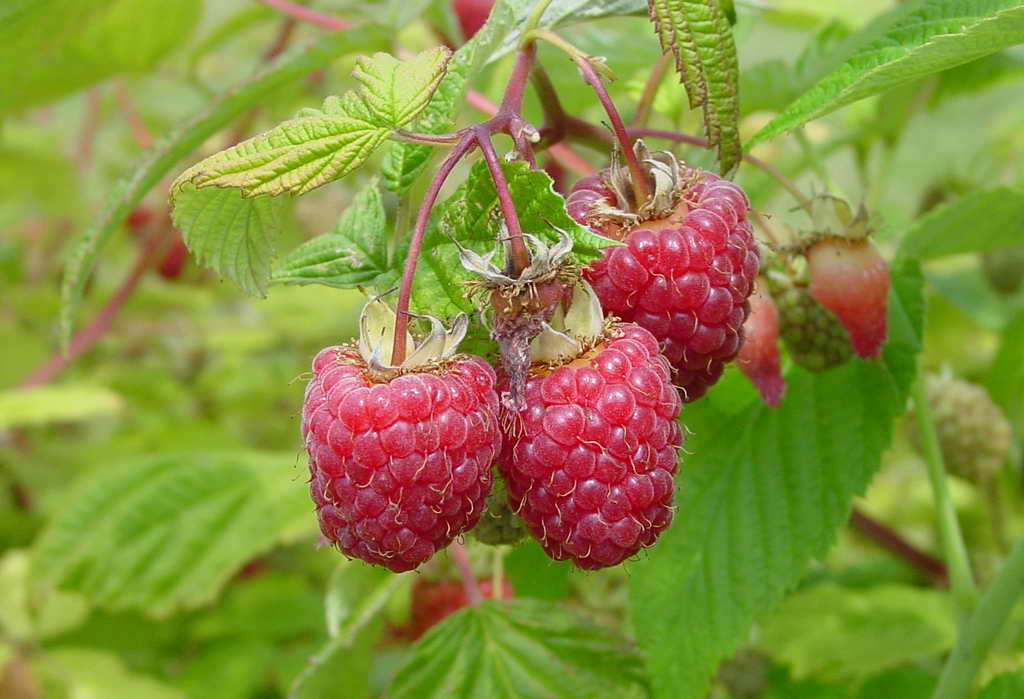
This year J thinned the rasberries to about half the density of last year and they have responded by producing more and bigger berries. It is hard to keep up on the rate of ripening and our freezer is getting full. It's not just the raspberries, but the peas, the salmon, the lingcod, and the crab. I'm going to pick up a small chest freezer for the basement. Then of course I'll need a generator, and another electrical panel to isolate it from the grid, and while I'm at it I might as while wire in the furnace, and ....
Of course while we are winning the yard war, the battles are not without casualties. Today J was weeding and stepped into a yellow jacket nest. She screamed like a girl. I applied baking soda paste since we didn't have any meat tenderizer. 6 hours later, while the stings itched they were just barely red. The next morning they still itched, but there was nothing noticable. Either good doctoring or a good immune system or both.
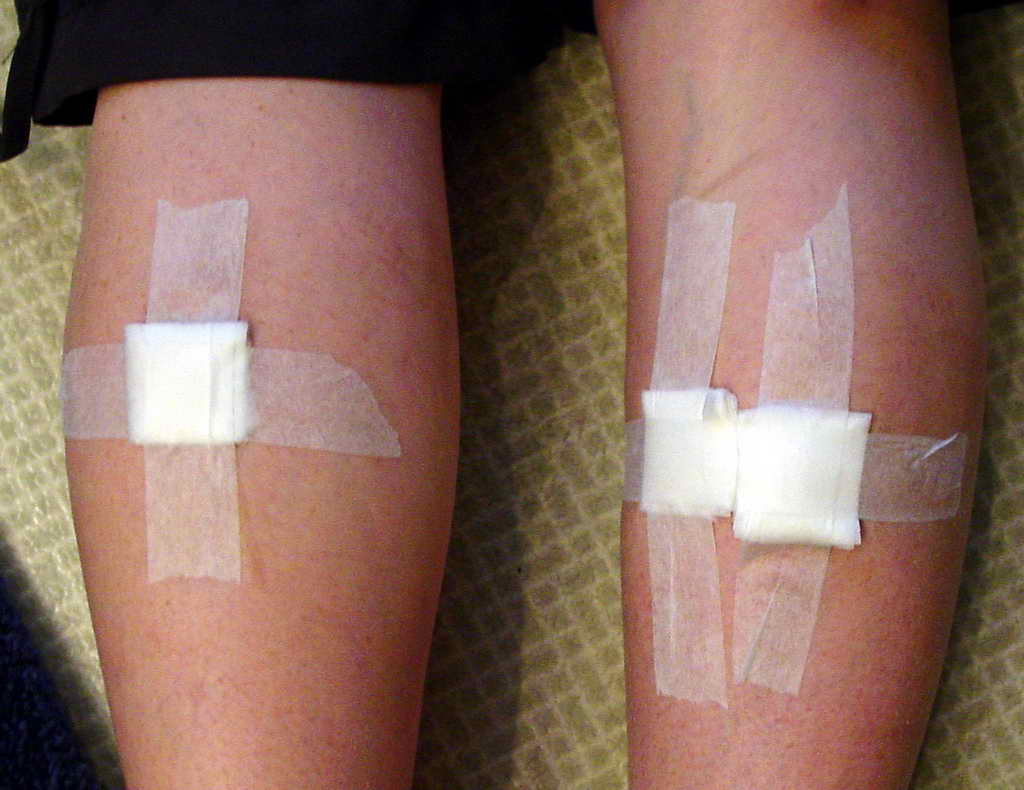
And finally the figs. Here is the Desert King with about 6 figs. They are growing fast. They were planted last August and it is probably good we had a mild winter. Not so good on the crummy spring, but at least the figs survived their first winter.
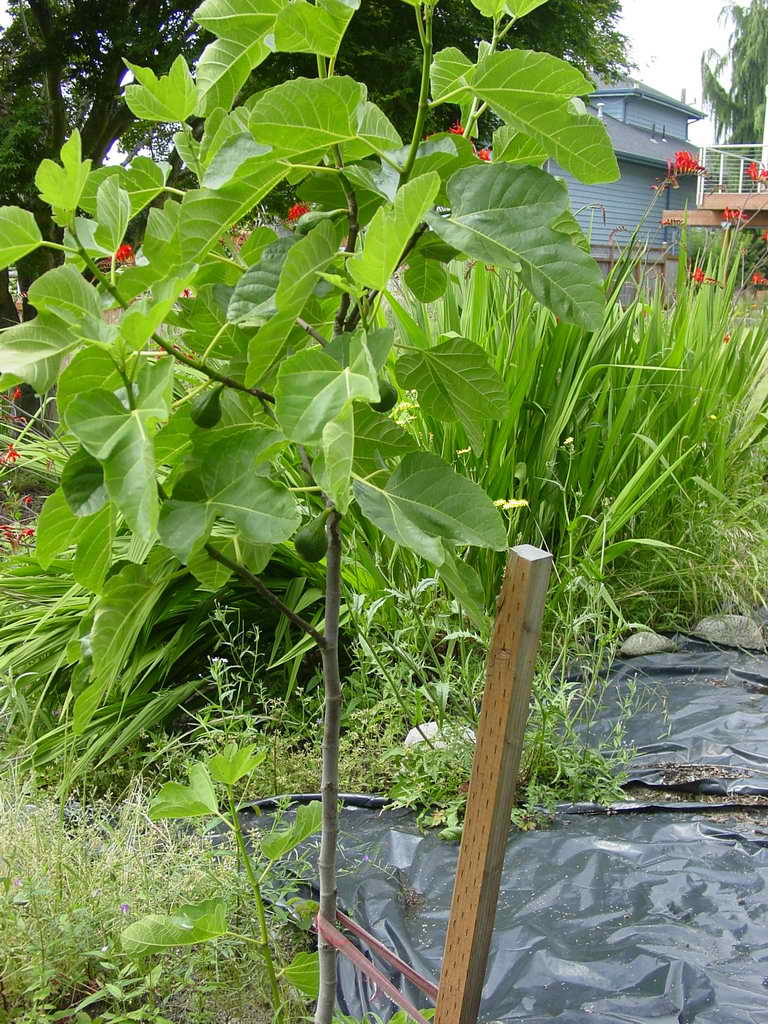
When the house was built in the 1980s someone thought it was a good idea to build walls and dividers with an endless number of railroad ties, some half-width, some full-width, and some double length. Now that they are rotting and home to carpenter ants, wasps, and other assorted insectivia it seems not such a good idea. Here's an example of the design when we moved in. This photo is of a corner of the half-sized ties that they used for the lesser beds and dividers. The red cedar cap hides most of the top tie and the bottom row is half buried. The full sized tie walls were 4 ties high and held together with 20p toenails at the ends and 12" spikes every few feet.
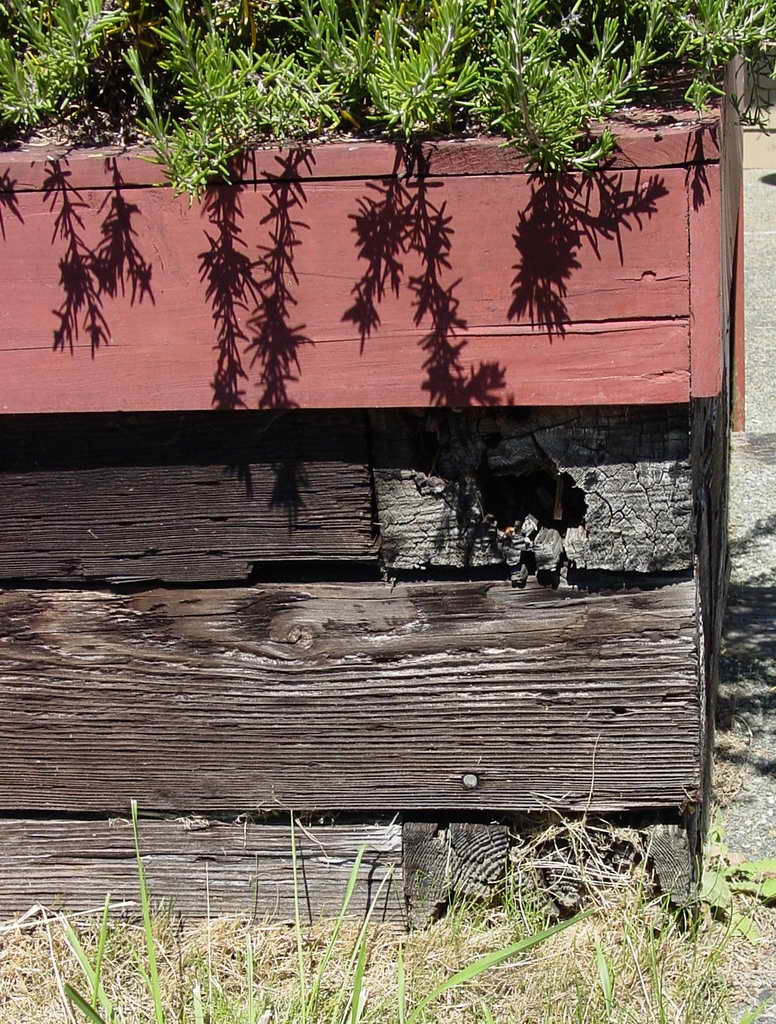
If expletives could change someone's afterlife whoever decided to use railroad ties is now roasting. My truck can haul about 1300 pounds in the bed with just me in the cab. That is only 60, 22lb wall blocks. Home Depot gets the blocks on pallets of 112. Home Depot will not load my truck and a full pallet at 2464 pounds would crush my truck. So, I get to hand load 60 blocks one at a time into my truck, drive home and unload 60 blocks. By the time those 60 blocks are in the backyard waiting to be set, I have lifted 2640 pounds and it's time for a nap. This wall is 5 rows of blocks high. The blocks are about 12" long. 60 blocks builds about 12' of wall. It's going to be a long process. Here are some of the railroad ties I pulled out for the Phase II 15 foot short run.
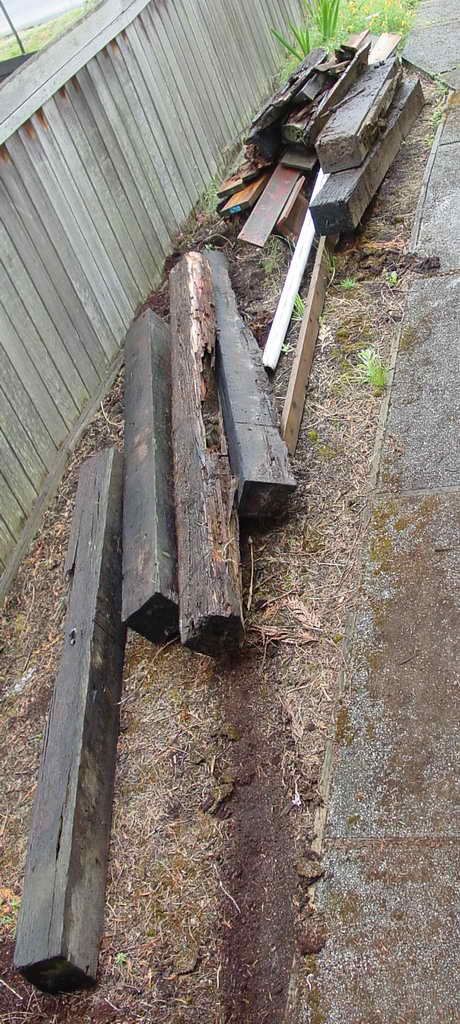
Here's the cleaned out trench, ready to be leveled, packed down, and the first row of blocks set. 90% of the time it takes to build this type of wall is in getting to the point that the first row is down. After that it is just stacking blocks. Note the level string. I used a 20' water level to shoot the ends. (The water level is a 20' piece of vinyl tubing filled with water and NO air bubbles.) I packed it down by lifting and pounding the cinder block into the dirt. In the lower right corner is the end of the last 10' buried tie that extends to the corner.
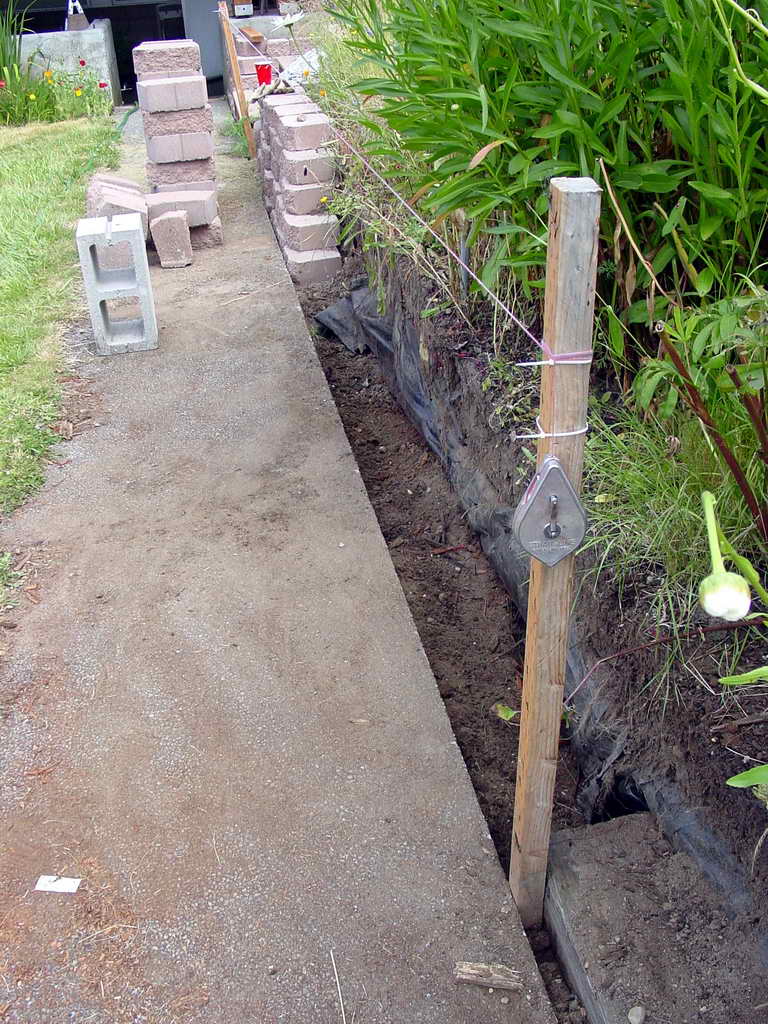
The first row, finally laid down.
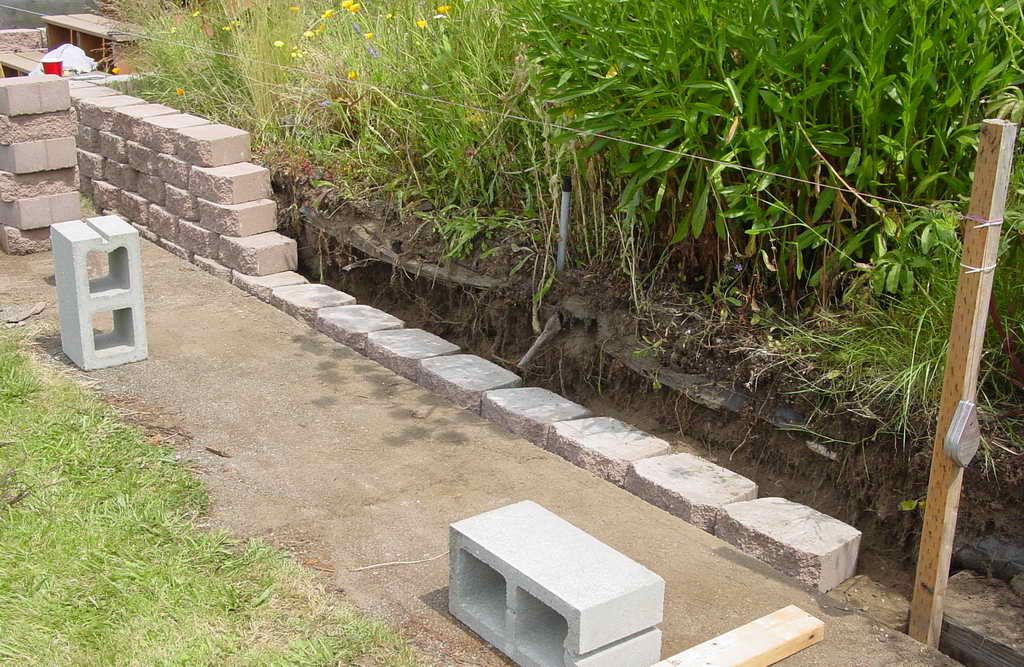
Phase II complete. There is still another 10 feet to finish to the right, and a 10 foot section running back to the rear of the flower bed. The cinder blocks are there to temporarily hold back the dirt.
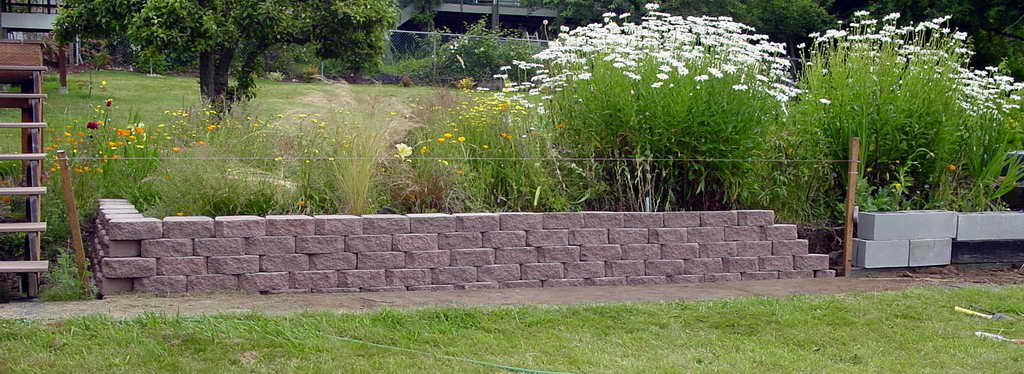
On the left you can just see the stairs and a 6' wing wall to hold the dirt back from the wood stairs. On the left side of the stairs out of frame, is my first block wall, 'L' shaped with another wing wall holding the dirt back from the other side of the stairs.